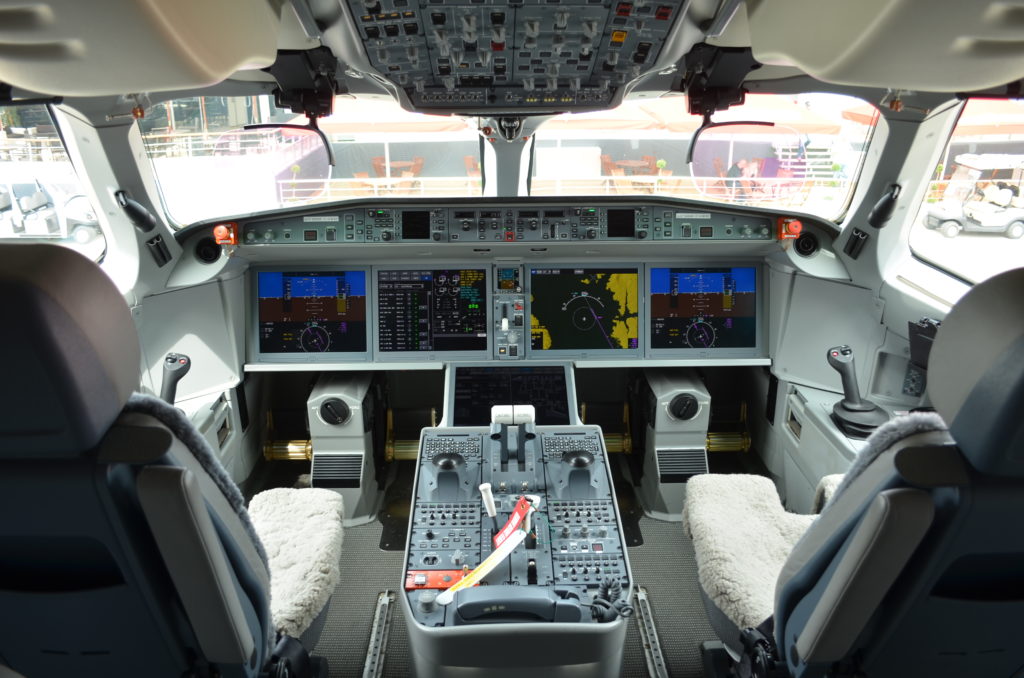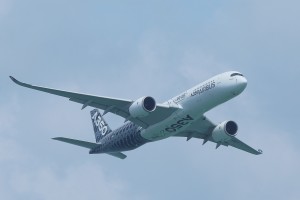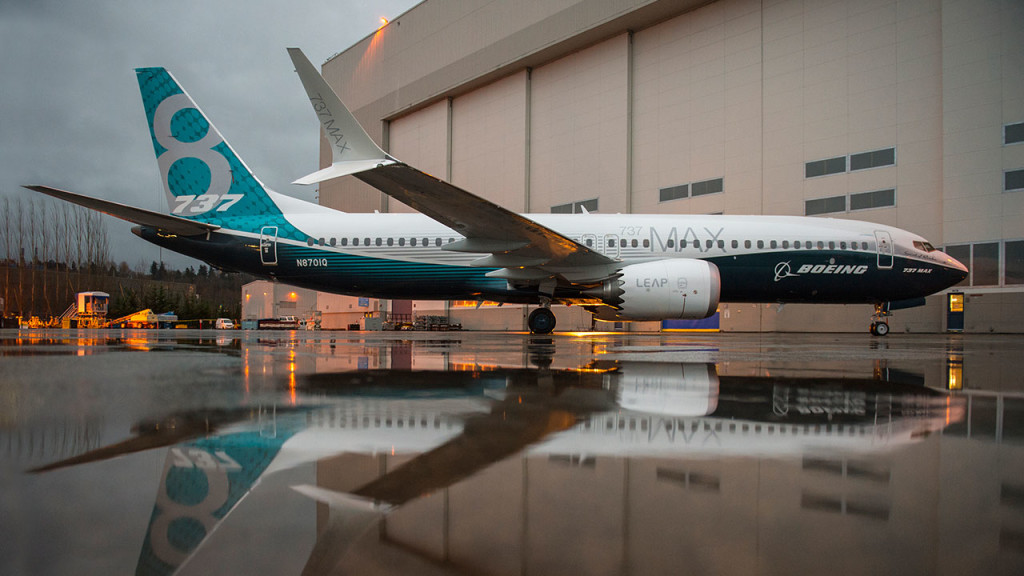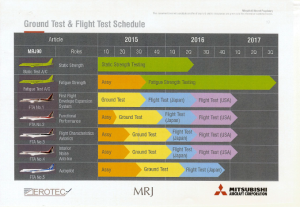Leeham News and Analysis
There's more to real news than a news release.
 Leeham News and Analysis
Leeham News and Analysis
- The Boeing 767 Cross Section, Part 1 November 24, 2022
- Movie Review: Devotion November 21, 2022
- China will accelerate development of its commercial aerospace sector November 21, 2022
- Bjorn’s Corner: Sustainable Air Transport. Part 46. eVTOL comparison with helicopter November 18, 2022
- The economics of a 787-9 and A330-900 at eight or nine abreast November 16, 2022
Bjorn’s Corner: C Series flight controls
29April 2016, ©. Leeham Co: With the order by Delta Air Lines, the Bombardier C Series has taken the step up to be a viable alternative to Airbus’ and Boeing’s single aisle 130-150 seat aircraft.
In my description of airliners’ flight control and Flight Management Systems (FMS), I have focused on the established mainline single aisle players. Time to change that; C Series has arrived and will stay in the mainline segment.
Why 130 seats as a limit? Because below 130 seats there are a number of additional players (Embraer, Sukhoi, Mitsubishi…) and we can’t describe them all right now.
Now to how Bombardier has implemented the flight controls, autopilot and FMS for the C Series. In fact, we will look at how they have made the C Series cockpit, Figure 1.
I haven’t flown the C Series yet (working on it!) but I have been able to glean quite a bit over time and spent quite some time in the cockpit with the Bombardier test pilots at the Paris Air Show.
So here is a shot at describing the C Series control philosophies and capabilities and how they mimic/differ from Airbus and Boeing.
Posted on April 29, 2016 by Bjorn Fehrm
IRKUT MC-21 analysis, Part 4. Performance with PD-14
By Bjorn Fehrm
Subscription required.
Introduction
March. 14, 2016, ©. Leeham Co: In three articles we have been looking at the new Russian single aisle aircraft, Irkut MC-21, from United Aircraft and the new Russian engine that is being developed for the aircraft, the PD-14.
The PD-14, which is offered as an alternative to the base engine for the aircraft, the Pratt & Whtiney PW1400G, was analysed in our Part 3 article. We now mount the engine on the MC-21 and explore the difference in performance compared to the base engine.
Summary:
- The PD-14, which is a new engine designed by the Aviadvigatel company, is a clear step forward for the Russian turbofan industry.
- In our analysis in Part 3, we could see that it has a classical direct drive construction with a good level of technology in several parts.
- Weight and installation dimension are similar to the competition but efficiency is a bit behind.
- We now explore the performance of the MC-21 with the Russian engine.
Posted on March 14, 2016 by Bjorn Fehrm
Singapore Air Show pictorial
Feb. 2123, 2016: The Singapore Air Show ended last week with a dearth of news. William Bain, associate professor and co-editor of International Relations, provided LNC with these photos.
Posted on February 23, 2016 by Scott Hamilton
Airbus, Boeing, Qatar Airways, Sukhoi
A350, A380, Airbus, Boeing, C-17, G550, Gulfstream, P-8, Singapore Air Show, SSJ100
Irkut MC-21, first analysis
By Bjorn Fehrm
Subscription required.
Introduction
Feb. 08, 2016, © Leeham Co: We recently covered China’s COMAC C919 and now the time has come to the other new narrow body aircraft from the old Communist bloc, the Russian MC-21.
The aircraft is called Irkut MC-21. Not many have heard of Irkut, so the first reaction is that this aircraft is made by a new Russian aircraft firm. The change is that United Aircraft (the Russian aircraft industry holding company) this time called the aircraft after its manufacturing company and not the design bureau, Yakovlev, that Irkut acquired in 2004. There are discussions to change back to the project’s original name Yakovlev 242 once certification is done.
When we looked at the first civil airliner that the Russian federation designed after the fall of Soviet Union, the Sukhoi Superjet 100, we found a well designed aircraft equipped with Western system. The MC-21 follows the same lines, but has more Russian technological development. It is therefore well worth a look.
Summary:
- The MC-21 has its own profile. It is not a copy of a Western aircraft. It has a wider cabin than the A320, a wing which allows a higher cruise speed and a higher capacity in its base variant, the MC-21-300.
- To make a meaningful comparison between the MC-21 and established aircraft, we have chosen to compare the MC-21-200 with the Airbus A320neo, as the MC-21-300 is larger than the A320neo but smaller than an A321neo. The MC-21-200 is closer in size to an A320neo. Read more
Posted on February 8, 2016 by Bjorn Fehrm
Bjorn’s Corner: Exciting 2016
29 January 2016, ©. Leeham Co: In the corner of two weeks ago we did a retrospective of 2015. Time for looking ahead. The year of 2016 will be quite interesting. We had entry into service of the first re-engine single aisle aircraft this week, the Airbus A320neo, the same week as we expect first flight from its main competitor, Boeing’s 737 MAX 8. We will also see first flight of the Embraer E190E2 and A350-1000 before the year is over.
The Mitsubishi MRJ shall go test flying in earnest and Bombardier’s CSeries 100 and 300 shall enter service. On top of that, the COMAC 919 will probably start ground roll tests this year and we should see roll out of Irkut’s MC-21. I would say 2016 is a busy year for civil aviation.
In the 2015 corner we talked a lot about engine technology as a key driver to further efficiency of air transportation. Now will dissect the airframe technology that all these new projects will bring us. Read more
Posted on January 29, 2016 by Bjorn Fehrm
Analysis: Sukhoi’s regional jet SSJ100, Part 2
By Bjorn Fehrm
Subscription required
Introduction
21 January 2016, ©. Leeham Co: The first part of our analysis, published Monday, looked at Russia’s first effort to design and aircraft to penetrate the Western airplane market, Sukhoi Superjet (SSJ100). We concluded that the SSJ100 regional airliner was a good effort.
The aircraft was essentially a Russian airframe with Franco-Russian engines, Western systems and Western avionics. For aircraft that are delivered to Western airlines, it also has an Italian-designed/produced interior.
The aircraft has been in successful deployment with Interjet of Mexico and has now been ordered by CityJet of Dublin. After having looked at base characteristics of the aircraft/engine and also analysed the fuel consumption, we now continue with developing the Cash and Direct Operating Costs of the SSJ100. We compare it with the market leader in the 100 seats regional market, Embraer’s E190.
Summary:
- The SSJ100 is competitive on fuel costs compared to the E190.
- Maintenance costs for SSJ100 is still hard to predict as there is still too limited operational experience.
- Capital costs are lower for the SSJ100. This means that Direct Operating Costs, DOC, are attractive for the SSJ100.
Posted on January 21, 2016 by Bjorn Fehrm
Analysis: Sukhoi’s regional jet Superjet 100
By Bjorn Fehrm
Subscription required
Introduction
18 January 2016, © Leeham Co: Russian aircraft have never succeeded in penetrating the Western market. But then they never really tried, until now. They were designed for the Soviet Union captive market, including the partner states that historically participated in or were friendly to the communistic system. One comes to think of China, Egypt, Libya, Cuba and Nicaragua. The Sukhoi Civil Aircraft Company (SCAC) Superjet 100 (SSJ100) is the first Russian aircraft specifically designed from the outset to compete on a world market.
The Sukhoi Civil Aircraft Company (SCAC) Superjet 100 (SSJ100) is the first Russian aircraft specifically designed from the outset to compete on a world market.
We analyse its basic design and performance in comparison to the market leader in 100 seat regional flying, Embraer’s E190.
Summary:
- The SSJ100 is a half a generation younger design than the Embraer E190. It has modern aerodynamics, IMA-based modular avionics and an advanced Fly-By-Wire system.
- The feedback-based Fly-By-Wire enables a tight aircraft design with low wetted areas.
- The SSJ100 engines, SaM146, can best be described as a shrinked and cleaned up CFM56. They have the efficiency level of the E190’s CF34-10E.
- The aerodynamics and engines combine to give the SSJ100 a single digit edge in fuel burn over the E190.
Posted on January 18, 2016 by Bjorn Fehrm
Embraer’s fundamental advantages
Subscription Required
Introduction
With the first Embraer E-Jet E2 under assembly, we take a look at the E1 and E2 programs in the run-up to ![]() roll-out of the E-190 E2 next year and projected Entry Into Service (EIS) in 2018.
roll-out of the E-190 E2 next year and projected Entry Into Service (EIS) in 2018.
Summary
- Broad customer base gives Embraer a major advantage against new competitors.
- More than 2,300 ERJs, E-Jets in service.
- More than 1,100 E-Jets in service.
- Broad product support a key advantage.
Posted on November 9, 2015 by Scott Hamilton
Bjorn’s Corner: Russian aircraft industry.
22 August 2015, ©. Leeham Co: The Russian air show MAKS is taking place in Moscow, on the airfield of Zhukovsky, Southeast of Moscow. The town of Zhukovsky is called the Aero-City of the Russian federation. It houses not only a 17,800ft runway but also the center of the Russian aeronautical research and test knowledge around the gigantic airfield.
Just a couple of miles from the airfield lies the well-known Russian Central Aerohydrodynamic Institute, TsAGI. It has been involved in designing the aerodynamics of all Russian aircraft, including the latest, the Sukhoi Superjet and Irkut’s new MC-21 competitor to the Boeing 737 MAX and Airbus A320neo.
I have always been interested in the enigma of the Soviet and later Russian aeronautical industry. It had such a different structure to its western counterparts and has therefore struggled. The MC-21 is a good example. Ilyushin says they are working on MC-21, as does Yakolev and Irkut. Irkut says it is their aircraft, yet I had not heard of Irkut as a plane OEM before MC-21.
My household names for Russian airliners were Tupolev and Ilyushin with perhaps Yakolev for the smaller types. If we included Ukraine during the Soviet period, we could add Antonov as a known airliner OEM. But not Irkut. Yet today the main players doing new civil airliners are Sukhoi and Irkut, neither known for building airliners. How does this all fit together? Here is a try to sort it out. Read more
Posted on August 28, 2015 by Bjorn Fehrm
Mitsubishi opens Seattle Engineering Center ahead of MRJ90 first flight
August 3, 2015, © Leeham Co.: Mitsubishi Aircraft Corp. today opened its Seattle Engineering Center jointly with local company AeroTEC in advance of the first flight of the MRJ90 in September or October. During the second quarter of next year, four of five MRJ Flight Test Vehicles will be domiciled in Moses Lake in Central Washington for the bulk of the flight testing over the following year. Entry into service is planned for 2Q2017 with launch customer All Nippon Airways.
The engineering center represents the first in Washington State for an aircraft OEM other than Boeing. Mitsubishi will assign 50 engineers from Japan to the new SEC, in South Seattle a short distance from Boeing Field. One hundred engineers will be hired locally.
AeroTEC and Mitsubishi began discussing working together only last January, said president Lee Human, who added that the seven months from January to the opening of the SEC today was remarkable for the speed in which negotiations, contracts, permits and hiring was achieved.
Posted on August 3, 2015 by Scott Hamilton
Email Subscription
Twitter Updates
My TweetsAssociations
Aviation News-Commercial
Commentaries
Companies-Defense
Resources
YouTube
Archives
- November 2022
- October 2022
- September 2022
- August 2022
- July 2022
- June 2022
- May 2022
- April 2022
- March 2022
- February 2022
- January 2022
- December 2021
- November 2021
- October 2021
- September 2021
- August 2021
- July 2021
- June 2021
- May 2021
- April 2021
- March 2021
- February 2021
- January 2021
- December 2020
- November 2020
- October 2020
- September 2020
- August 2020
- July 2020
- June 2020
- May 2020
- April 2020
- March 2020
- February 2020
- January 2020
- December 2019
- November 2019
- October 2019
- September 2019
- August 2019
- July 2019
- June 2019
- May 2019
- April 2019
- March 2019
- February 2019
- January 2019
- December 2018
- November 2018
- October 2018
- September 2018
- August 2018
- July 2018
- June 2018
- May 2018
- April 2018
- March 2018
- February 2018
- January 2018
- December 2017
- November 2017
- October 2017
- September 2017
- August 2017
- July 2017
- June 2017
- May 2017
- April 2017
- March 2017
- February 2017
- January 2017
- December 2016
- November 2016
- October 2016
- September 2016
- August 2016
- July 2016
- June 2016
- May 2016
- April 2016
- March 2016
- February 2016
- January 2016
- December 2015
- November 2015
- October 2015
- September 2015
- August 2015
- July 2015
- June 2015
- May 2015
- April 2015
- March 2015
- February 2015
- January 2015
- December 2014
- November 2014
- October 2014
- September 2014
- August 2014
- July 2014
- June 2014
- May 2014
- April 2014
- March 2014
- February 2014
- January 2014
- December 2013
- November 2013
- October 2013
- September 2013
- August 2013
- July 2013
- June 2013
- May 2013
- April 2013
- March 2013
- February 2013
- January 2013
- December 2012
- November 2012
- October 2012
- September 2012
- August 2012
- July 2012
- June 2012
- May 2012
- April 2012
- March 2012
- February 2012
- January 2012
- December 2011
- November 2011
- October 2011
- September 2011
- August 2011
- July 2011
- June 2011
- May 2011
- April 2011
- March 2011
- February 2011
- January 2011
- December 2010
- November 2010
- October 2010
- September 2010
- August 2010
- July 2010
- June 2010
- May 2010
- April 2010
- March 2010
- February 2010
- January 2010
- December 2009
- November 2009
- October 2009
- September 2009
- August 2009
- July 2009
- June 2009
- May 2009
- April 2009
- March 2009
- February 2009
- January 2009
- December 2008
- November 2008
- October 2008
- September 2008
- August 2008
- July 2008
- June 2008
- May 2008
- April 2008
- March 2008
- February 2008






